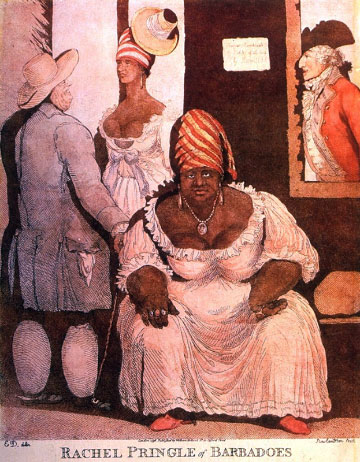Rachel Pringle Polgreen circa 1753 — 1791

Rachel Pringle Polgreen was born Rachel Lauder to an enslaved African mother and white master and father, William Lauder, in Barbados around 1753. Rachel was shielded from her father’s abuse by Thomas Pringle, who provided Rachel with a house and her freedom in exchange for her sexual favors. Rachel dropped her Lauder surname and adopted Pringle’s.
After a scandal in which Rachel allegedly faked a pregnancy in order to “establish more influence over her benefactor,” Thomas Pringle ended his relationship with Rachel and left for Jamaica. Rachel quickly found security under another man, Polgreen, whose surname she added to her own, becoming Rachel Pringle Polgreen.
Under Polgreen’s patronage, Rachel was able to open a tavern and her famous Royal Navy Hotel in Bridgetown during the 1770s. Her hotel, offering sexual pleasures to sailors in the British Royal Navy, acquired its name from an alleged encounter with Prince William Henry, who became King William IV of England. As reported, the Prince and his companions came to Polgreen’s hotel and, in a drunken rampage, destroyed it. The next morning Rachel sent the Prince a bill for the damages done to her hotel. The Prince, impressed, paid the bill, which was enough to fully refurnish her hotel in more splendor and extravagance than it had before.
Rachel Pringle Polgreen died on July 23, 1791, at the age of 48. At her death, she owned a considerable amount of property, including buildings, liquid assets, and slaves.
Much of the information on Rachel Pringle Polgreen is provided by J.W. Orderson’s Creolana or Social and Domestic Scenes and Incidents in Barbados in the Days of Yore. Though some events are corroborated by primary sources, some scholars question how we should interpret the evidence provided by Creoleana and available primary sources. In her article “Power and Historical Figuring: Rachael Pringle Polgreen’s Troubled Archive,” Marisa Fuentes argues that Orderson’s novel should not be dismissed as providing historical information on Polgreen, but it should be viewed critically, within the social and cultural contexts of the novel. Orderson, she argues, was writing a “sentimental” novel with the goal of guiding moral behavior between the races in a post-emancipation society and his narrative may have “produced a distorted [and] disfigured” image of Polgreen, especially in her triumph after Prince William Henry’s visit.






